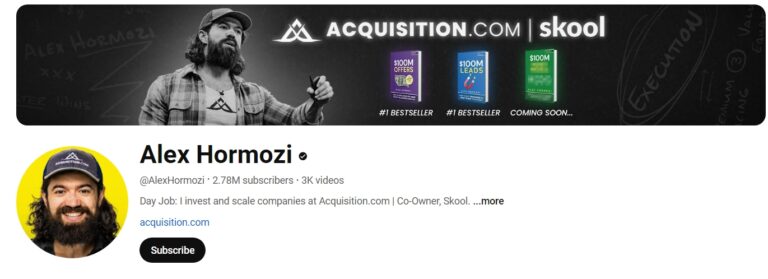Mastering Sales Techniques: Proven Closing Strategies to Boost Your Success
Alex Hormozi
Alex Hormozi is a highly successful entrepreneur and investor, known for his exceptional ability to scale companies and deliver transformative business growth. As a co-owner of Acquisition.com, Alex has made…
Key Take-aways
- Rational buyers create long-term relationships; emotional buyers may second-guess their decisions.
- Sales success stems from understanding customer objections and guiding them through logic-based decisions.
- Handling objections like price and time constraints can transform a “no” into a long-lasting partnership.
- Salesmanship is about helping people make decisions for their own benefit, not manipulating them.
- Focus on the person, not the sale. Winning their trust ensures the relationship lasts.
Sales is both an art and a science, balancing the emotional and logical sides of decision-making. The best salespeople help their prospects make rational decisions that stick, long after the emotional high of a purchase wears off. Whether you’re selling high-ticket items or everyday products, these proven sales techniques will help you build trust and close deals that last.
1. Balancing Emotion and Logic in Sales
While emotional buyers may be swayed quickly, their excitement can fade just as fast, leading to buyer’s remorse. Logical buyers, on the other hand, stay committed because their decisions are grounded in reason. As Charlie Munger, the renowned investor, says: “We have a high moral responsibility to be rational.” In sales, it’s important to help customers build a rational foundation for their buying decisions.
- Emotional buys may seem exciting, but logic ensures lasting customer satisfaction.
- Help prospects justify their decisions with logic that complements their emotions.
2. Handling Common Objections: Price, Time, and Fit
Objections are part of the game in sales. The best salespeople are ready to handle these with confidence. Price objections? Use a high-price anchor and walk it back down to make your final offer seem more attractive. Time objections? Help the prospect realize they’ll always be busy, so it’s best to learn how to implement solutions now. If a prospect isn’t sure if the product is a fit, emphasize how a new identity requires new priorities—which often means making changes to achieve desired outcomes.
- Price: Always start with a higher figure to create a price anchor. This makes your actual offer feel more reasonable.
- Time: Emphasize the importance of acting now. If they wait for the perfect time, they may never start.
- Fit: Remind prospects that new goals require stepping into a new identity, which often means changing habits and spending patterns.
3. Obstacle vs. Objection: Know the Difference
In sales, it’s crucial to distinguish between obstacles and objections. Obstacles occur before the sales pitch even starts. For instance, a prospect might say, “I’m just gathering information,” but in reality, they’re trying to solve a problem. Objections come after the pitch when the buyer disagrees with your offer or approach. Knowing when to tackle obstacles and objections will make your sales process more efficient.
4. Overcoming “No” with Power and Confidence
In sales, you have to expect the “no”—it’s part of the job. Instead of seeing it as failure, view it as an opportunity to coach the buyer toward a better decision. Sales is the first step toward a coaching relationship because it’s about helping prospects make decisions that benefit them. Use “no” as a signal to ask more questions and better understand their concerns.
- Accept “no” as part of the process and use it as a learning tool.
- Guide your prospects toward realizing that their objections often stem from fear or uncertainty.
5. Always Be Closing: Selling Happens All the Time
Selling doesn’t just happen at the point of asking for the sale—it happens throughout the entire conversation. By focusing on the person and not just the sale, you build rapport and trust. This leads to better results when it’s time to close.
6. Using Hypothetical Scenarios to Close
When dealing with objections, hypothetical scenarios can be powerful. Ask the prospect, “If this were perfect for you, would you do it?” This helps them see the issue isn’t with the offer, but perhaps with their own uncertainties. By walking them through the hypothetical, you can address any remaining concerns.
7. Your Greatest Power: Transferring Belief
Sales is a transference of belief over a bridge of trust. If you truly believe in your product and can communicate that belief, your prospect will trust you. And trust is the foundation of any sale.
8. The Hard Questions Are Key
If you want to help your prospect transform, you have to ask the hard questions. What’s really holding them back? Why haven’t they made this decision yet? As a salesperson, you care about your prospect’s success more than anyone else, and it’s your job to help them overcome their own objections to growth.
Mastering these sales techniques will elevate your ability to connect with prospects, overcome objections, and ultimately close deals that stick. By staying focused on the person, using logic to address their concerns, and building trust, you’ll find greater success in your sales career.

